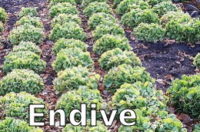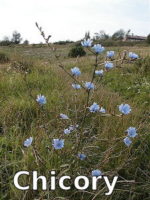Endive and Chicory
 Endive and chicory are winter salad greens that have a slightly bitter flavor. They are more popular in Europe, but recent introductions if Italian red chicory, called Radicchio (re-dee-kee-o) has spawned interest among home gardeners. There are forcing and non-forcing types. There are varieties that need cold to induce heading and color change. And there are a few varieties that turn red without cold temperatures - these are the kind to grow in San Diego County. There is still not much local information on cultural practices. Some seed suppliers will send you a culture sheet.
Endive and chicory are winter salad greens that have a slightly bitter flavor. They are more popular in Europe, but recent introductions if Italian red chicory, called Radicchio (re-dee-kee-o) has spawned interest among home gardeners. There are forcing and non-forcing types. There are varieties that need cold to induce heading and color change. And there are a few varieties that turn red without cold temperatures - these are the kind to grow in San Diego County. There is still not much local information on cultural practices. Some seed suppliers will send you a culture sheet.
If you enjoy trying new vegetables, grow this on a trial basis with some of the latest seed introductions. Learn all you can about planting dates and cultural needs for our area.
 Endive is generally used as a salad garnish because of its curly leaves and cream-colored heart. Italian dishes use it sautéed or baked. Another chicory gourmet item, called Witloof chicory, is forced during winter to produce blanched, golden, cone shaped shoots that are used as a salad dish.
Endive is generally used as a salad garnish because of its curly leaves and cream-colored heart. Italian dishes use it sautéed or baked. Another chicory gourmet item, called Witloof chicory, is forced during winter to produce blanched, golden, cone shaped shoots that are used as a salad dish.
All the non-forcing types of endive and chicory have the same growing requirements: fertile, well-drained soil, cool temperatures for maturity, and plenty of water. Problems: Botrytis rot or grey mold during cool wet weather. Overcrowding and poor drainage should be corrected. Pests are unusual. However, sow bugs and earwigs will hide in and under plants. Trap or bait for both.
Planting Dates
Coastal:
Seeds can be planted from September to May.
Inland:
Seeds can be planted from September to April.

